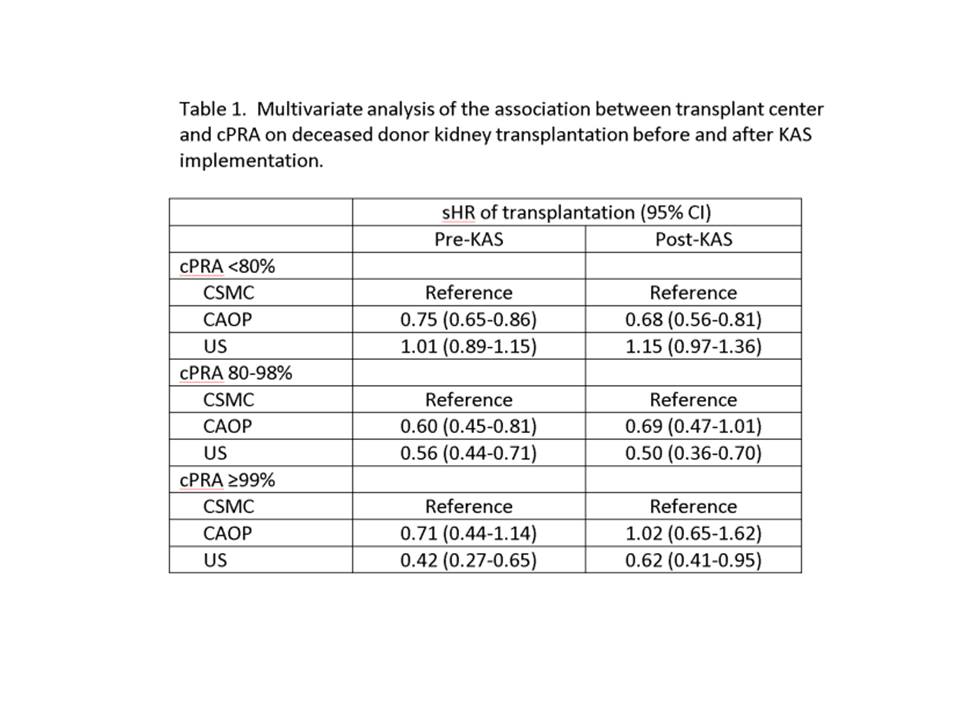Waitlist Desensitization and the Rate of Deceased Donor Kidney Transplantation After Implementation of the Kidney Allocation System.
Comprehensive Transplant Center, Cedars Sinai Medical Center, Los Angeles, CA
Meeting: 2017 American Transplant Congress
Abstract number: 121
Keywords: Allocation, Kidney transplantation, Sensitization, Waiting lists
Session Information
Session Name: Concurrent Session: Kidney Allocation: Changes and Consequences
Session Type: Concurrent Session
Date: Sunday, April 30, 2017
Session Time: 4:30pm-6:00pm
 Presentation Time: 5:18pm-5:30pm
Presentation Time: 5:18pm-5:30pm
Location: E450a
Background:
At Cedars Sinai Medical Center (CSMC), candidates with calculated panel reactive antibodies (cPRA) ≥30% (based on unacceptable antigens with MFI≥15,000) are desensitized while awaiting transplant. We examined the impact of waitlist desensitization on deceased donor transplant (DDKT) rates pre- and post-kidney allocation system (KAS).
Methods:
Using OPTN/UNOS data, the cumulative incidence (CI) of DDKT among adult candidates waitlisted 21 months before and after KAS at CSMC was compared to other centers in our donation service area (One Legacy, CAOP) and nationally (US). Competing risks methods were employed to account for death and delisting as competing events. Candidates were categorized according to cPRA: <80%, 80-98%, and ≥99%.
Results:
The CI of DDKT was higher pre-KAS for candidates at CSMC compared to CAOP and the US. Post-KAS, the CI was higher at CSMC compared to CAOP, but was not different than the US (Figure 1). After adjusting for confounders, candidates with cPRA<80% and 80-98% at CSMC were more likely to be transplanted pre-KAS compared to CAOP (Table 1). CSMC candidates with cPRA<80% were more likely to be transplanted post-KAS than CAOP; among cPRA 80-98%, there was a trend toward higher likelihood of transplant at CSMC compared to CAOP (p=0.06). Candidates with cPRA 80-98% and ≥99% were more likely to be transplanted at CSMC than the US pre- and post-KAS.
Conclusion:
Pre-transplant desensitization at CSMC was associated with a higher CI of DDKT among highly sensitized candidates compared to national candidates. Locally, there was a trend toward higher CI of DDKT among candidates at CSMC with cPRA 80-98% compared to CAOP and no difference among those with cPRA ≥99%, which may be due to different thresholds for unacceptable antigens between centers.

CITATION INFORMATION: Huang E, Jordan S, Najjar R, Choi J, Peng A, Vo A. Waitlist Desensitization and the Rate of Deceased Donor Kidney Transplantation After Implementation of the Kidney Allocation System. Am J Transplant. 2017;17 (suppl 3).
To cite this abstract in AMA style:
Huang E, Jordan S, Najjar R, Choi J, Peng A, Vo A. Waitlist Desensitization and the Rate of Deceased Donor Kidney Transplantation After Implementation of the Kidney Allocation System. [abstract]. Am J Transplant. 2017; 17 (suppl 3). https://atcmeetingabstracts.com/abstract/waitlist-desensitization-and-the-rate-of-deceased-donor-kidney-transplantation-after-implementation-of-the-kidney-allocation-system/. Accessed November 27, 2025.« Back to 2017 American Transplant Congress
